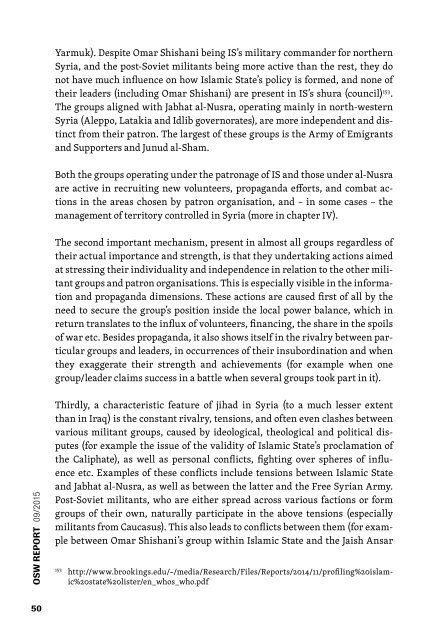HOMO JIHADICUS
homojihadicus
homojihadicus
Create successful ePaper yourself
Turn your PDF publications into a flip-book with our unique Google optimized e-Paper software.
Yarmuk). Despite Omar Shishani being IS’s military commander for northern<br />
Syria, and the post-Soviet militants being more active than the rest, they do<br />
not have much influence on how Islamic State’s policy is formed, and none of<br />
their leaders (including Omar Shishani) are present in IS’s shura (council) 153 .<br />
The groups aligned with Jabhat al-Nusra, operating mainly in north-western<br />
Syria (Aleppo, Latakia and Idlib governorates), are more independent and distinct<br />
from their patron. The largest of these groups is the Army of Emigrants<br />
and Supporters and Junud al-Sham.<br />
Both the groups operating under the patronage of IS and those under al-Nusra<br />
are active in recruiting new volunteers, propaganda efforts, and combat actions<br />
in the areas chosen by patron organisation, and – in some cases – the<br />
management of territory controlled in Syria (more in chapter IV).<br />
The second important mechanism, present in almost all groups regardless of<br />
their actual importance and strength, is that they undertaking actions aimed<br />
at stressing their individuality and independence in relation to the other militant<br />
groups and patron organisations. This is especially visible in the information<br />
and propaganda dimensions. These actions are caused first of all by the<br />
need to secure the group’s position inside the local power balance, which in<br />
return translates to the influx of volunteers, financing, the share in the spoils<br />
of war etc. Besides propaganda, it also shows itself in the rivalry between particular<br />
groups and leaders, in occurrences of their insubordination and when<br />
they exaggerate their strength and achievements (for example when one<br />
group/leader claims success in a battle when several groups took part in it).<br />
PRACE OSW REPORT OSW 09/2012 09/2015<br />
Thirdly, a characteristic feature of jihad in Syria (to a much lesser extent<br />
than in Iraq) is the constant rivalry, tensions, and often even clashes between<br />
various militant groups, caused by ideological, theological and political disputes<br />
(for example the issue of the validity of Islamic State’s proclamation of<br />
the Caliphate), as well as personal conflicts, fighting over spheres of influence<br />
etc. Examples of these conflicts include tensions between Islamic State<br />
and Jabhat al-Nusra, as well as between the latter and the Free Syrian Army.<br />
Post-Soviet militants, who are either spread across various factions or form<br />
groups of their own, naturally participate in the above tensions (especially<br />
militants from Caucasus). This also leads to conflicts between them (for example<br />
between Omar Shishani’s group within Islamic State and the Jaish Ansar<br />
153<br />
http://www.brookings.edu/~/media/Research/Files/Reports/2014/11/profiling%20islamic%20state%20lister/en_whos_who.pdf<br />
50


